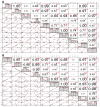Evaluating the Response of Glycine soja Accessions to Fungal Pathogen Macrophomina phaseolina during Seedling Growth
- PMID: 38005704
- PMCID: PMC10675638
- DOI: 10.3390/plants12223807
Evaluating the Response of Glycine soja Accessions to Fungal Pathogen Macrophomina phaseolina during Seedling Growth
Abstract
Charcoal rot caused by the fungal pathogen Macrophomina phaseolina (Tassi) Goid is one of various devastating soybean (Glycine max (L.) Merr.) diseases, which can severely reduce crop yield. The investigation into the genetic potential for charcoal rot resistance of wild soybean (Glycine soja) accessions will enrich our understanding of the impact of soybean domestication on disease resistance; moreover, the identified charcoal rot-resistant lines can be used to improve soybean resistance to charcoal rot. The objective of this study was to evaluate the resistance of wild soybean accessions to M. phaseolina at the seedling stage and thereby select the disease-resistant lines. The results show that the fungal pathogen infection reduced the growth of the root and hypocotyl in most G. soja accessions. The accession PI 507794 displayed the highest level of resistance response to M. phaseolina infection among the tested wild soybean accessions, while PI 487431 and PI 483660B were susceptible to charcoal rot in terms of the reduction in root and hypocotyl growth. The mean values of the root and hypocotyl parameters in PI 507794 were significantly higher (p < 0.05) than those of PI 487431 and PI 483460B. A analysis of the resistance of wild soybean accessions to M. phaseolina using the root and hypocotyl as the assessment parameters at the early seedling stage provides an alternative way to rapidly identify potential resistant genotypes and facilitate breeding for soybean resistance to charcoal rot.
Keywords: Glycine soja; Macrophomina phaseolina; WinRHIZO; charcoal rot resistance.
Conflict of interest statement
All authors declare no conflict of interest.
Figures






Similar articles
-
Identification of new sources of resistance to charcoal rot caused by Macrophomina phaseolina (Tassi) Goid in cowpea.BMC Plant Biol. 2025 May 17;25(1):659. doi: 10.1186/s12870-025-06628-1. BMC Plant Biol. 2025. PMID: 40382555 Free PMC article.
-
Facets of rhizospheric microflora in biocontrol of phytopathogen Macrophomina phaseolina in oil crop soybean.Arch Microbiol. 2021 Mar;203(2):405-412. doi: 10.1007/s00203-020-02046-z. Epub 2020 Sep 23. Arch Microbiol. 2021. PMID: 32965527 Review.
-
First Report of Charcoal Rot Caused by Macrophomina phaseolina in Soybean in New York.Plant Dis. 2013 Nov;97(11):1506. doi: 10.1094/PDIS-03-13-0318-PDN. Plant Dis. 2013. PMID: 30708496
-
First Report of Charcoal Rot (Macrophomina phaseolina) on Soybean in Minnesota.Plant Dis. 2003 Feb;87(2):202. doi: 10.1094/PDIS.2003.87.2.202C. Plant Dis. 2003. PMID: 30812936
-
Macrophomina phaseolina : General Characteristics of Pathogenicity and Methods of Control.Front Plant Sci. 2021 Apr 22;12:634397. doi: 10.3389/fpls.2021.634397. eCollection 2021. Front Plant Sci. 2021. PMID: 33968098 Free PMC article. Review.
References
-
- Carter T.E., Hymowitz T., Nelson R.L. Biogeography, local adaptation, vavilov, and genetic diversity in soybean. In: Boerma R., Specht J., editors. Biological Resources and Migration. Springer; Berlin/Heidelberg, Germany: 2004. pp. 47–59.
-
- Singh R.J., Hymowitz T. Soybean genetic resources and crop improvement. Genome. 1999;42:605–616. doi: 10.1139/g99-039. - DOI
LinkOut - more resources
Full Text Sources
Research Materials
Miscellaneous

